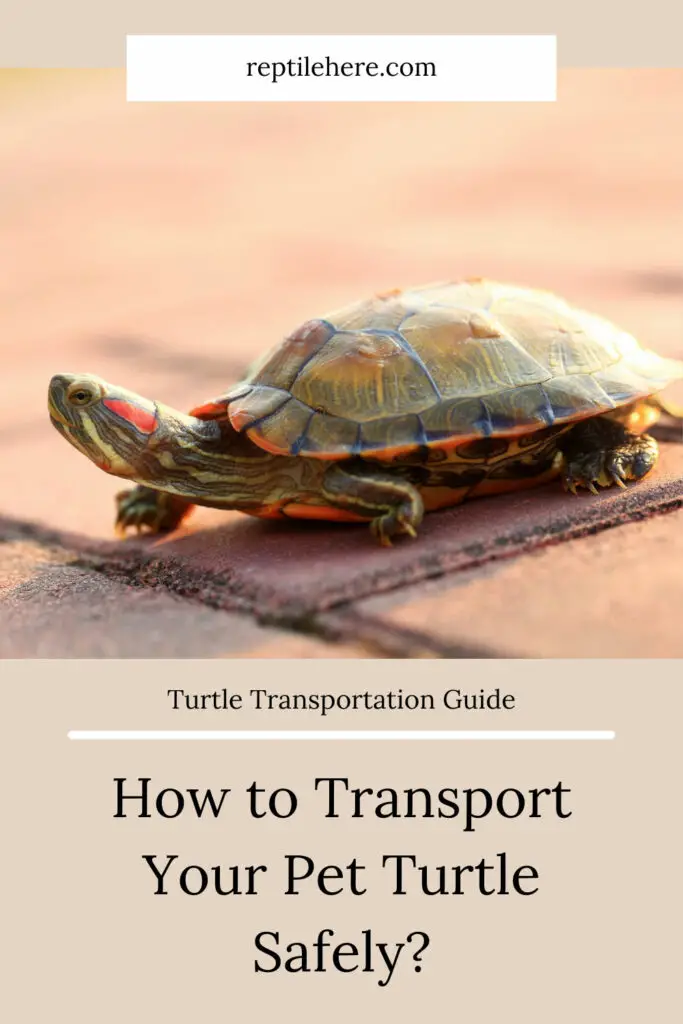How to Transport Your Pet Turtle Safely?
Whether you’re making a trip to the vet, moving to a new place, or simply going for a long trip across the country, you may be wondering about the best way to carry your turtle with you. You want to ensure you transport your little buddy most safely.
How to transport your pet turtle safely? You can safely transport your pet turtle in a sturdy container, e.g. a plastic box. Make sure the container has some good ventilation and the ambient temperature inside stays at the recommended range for your pet species. Remember to periodically check on your turtle.
Our guide below will give you helpful advice on how to safely transport your pet turtle in a safe and comfortable manner, what preparations to make in advance, and the different transportation options to consider.
Turtle transportation guide:
Contents
Here are some crucial tips to keep in mind when transporting your pet turtle:
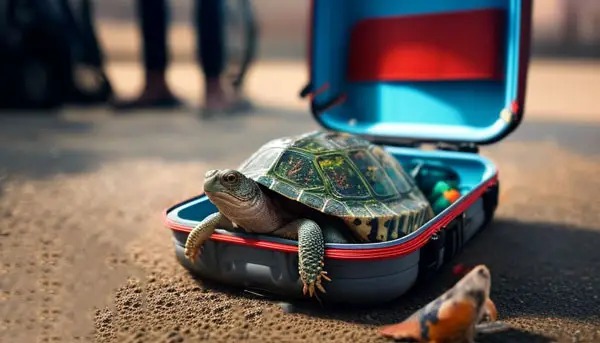
Choose a transportation option
The most popular methods of transportation for your pet turtle include travel carriers and insulated boxes.
- Travel carriers: These can be plastic containers or pet carriers. A good carrier should be spacious enough for your turtle to comfortably sit in and turn around. It should also be well-ventilated and secure to prevent your turtle from escaping during transportation.
- Insulated boxes: These are helpful when transporting your turtle for long trips and the weather is cold. The boxes come designed to help regulate the temperature inside, thus helping keep your turtle comfortable.
- DIY carrier: You can safely and comfortably transport your pet turtle by putting it in a sturdy and clean container such as a plastic shoe box or cardboard box. Don’t use anything rigid like a glass container that lacks ventilation.
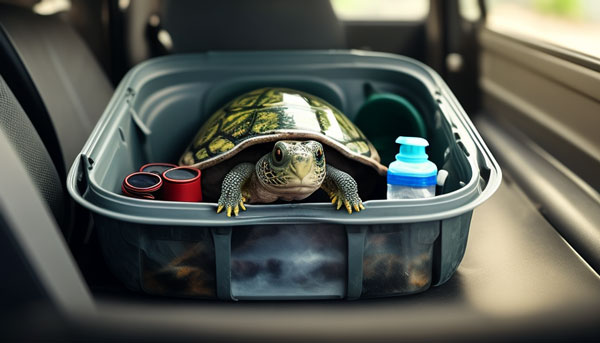
An ideal box should offer just enough space for your turtle to stay inside and turn around comfortably. Don’t use a box with too much space to move around.
Preparing the box
Line up the bottom of the container with padding of shredded newspaper, paper towel, or towel to act as the substrate.
Unlike what most turtle owners think, water isn’t necessary when transporting your turtle. Aquatic turtles can tolerate being out of the water for a while.
However, if you’re going for a long trip and your turtle will be inside the box for hours, then you may consider frequently misting it or even moistening its substrate.
But be sure to regularly check that no fungus or mold is growing inside the container due to the damp environment. This is especially true if you’re going on long trips.
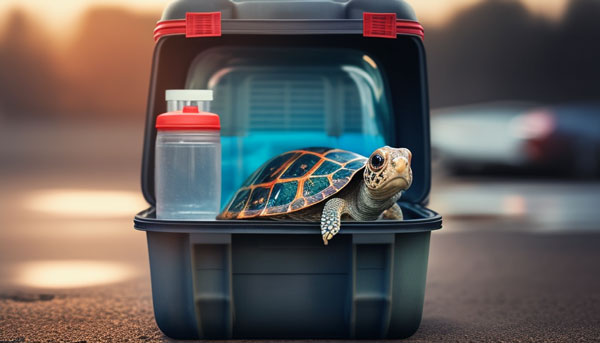
For even longer trips, you can provide your turtle with a shallow water dish filled with water to allow your turtle to get in if it feels the need to.
Make sure the box you choose has a lid that closes securely to help prevent your turtle from escaping.
Additionally, the lid will help keep the draft from getting to your turtle. If possible, keep the inside of the container dark.
Acclimation to the new home
You may also want to acclimate your turtle to its transportation container or carrier by placing it there a few times before the trip.
This will help your turtle get used to it, and can go a long way in helping reduce stress and anxiety in your little guy during the actual transportation.
Ventilation is crucial
Make sure the box has sufficient ventilation to allow air to flow in and out freely to avoid suffocating your little guy inside there.
If your container doesn’t have holes, you can drill them yourself. If you’re going for extended trips, you may also want to periodically open the turtle container to help it get some fresh air.
Temperature regulation during transit
You’ll also need to ensure the ambient temperature stays at the optimal range for your specific turtle species throughout the trip. A thermometer will help you monitor this temperature range.
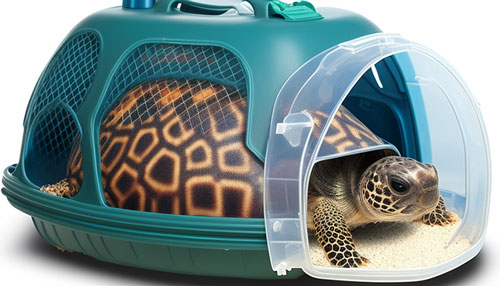
Remember, turtles are cold-blooded and depend on their environment to help them regulate their body temperature.
You should be more worried about your turtle getting overheated than being cool. This is because the former can make it sluggish and may even become sick. (Source).
Transporting your turtle in warm weather:
If you’re traveling in warm weather, you may consider regularly misting your turtle or keeping its substrate damp during the trip. As this water evaporates, it creates a cooling effect around your turtle.
Alternatively, you can rely on your car’s air conditioning to keep the interior cool and thereby keep your pet turtle from overheating.

Some turtle owners also suggest placing the turtle box inside a cooler (Styrofoam will be a good choice) and then adding a cool pack to it. Keeping the cooler open is key for proper aeration.
Putting the cooler pack or one pack directly into your turtle’s box isn’t recommended. The pack shouldn’t be anywhere near your turtle.
Transporting your turtle in cold weather:
If you’re traveling in cool weather, you may also consider using a warmer pack, just the same way you’d use a cooler pack in hot weather. Place your turtle carrier inside the cooler box and then have the warmer pack wrapped around it.
The pack can be a heating pad, a bottle filled with hot water, sock containing heated rice, microwaved potato, etc. Whatever your do, don’t make your turtle get into contact with this hot pack.
Regularly monitor your turtle
Make sure you regularly check on your shelled buddy if you’re going for long trips.
For instance, every time you stop to get some gas, you can check how your pet turtle is doing inside the box.
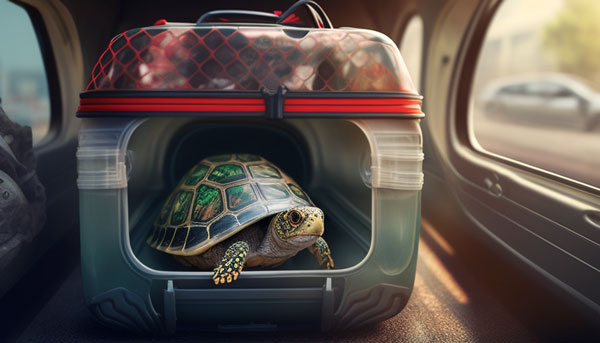
This is important to ensure your turtle doesn’t flip over and unable to get itself back up and to remove any waste your turtle may have excreted.
Check the following video on how to safely transport your pet turtle:
Video:
Do you need to bring food when transporting your turtle?
Food isn’t necessary when transposing your turtle as these creatures can go for a day without eating. You can feed your turtle before the trip and see what its appetite is like for the rest of the trip.
An adult turtle’s feeding schedule should be after every 2-3 days. However, if you have a young or juvenile turtle, it’ll heartily eat every day, so you should make sure you bring enough food for the length of the trip.
How to transport a turtle on an airplane?
To transport your turtle on an airplane, you should first check with the airlines on the policies regarding flying with pets.
If they allow traveling with pets, go ahead and enquire if they require any additional paperwork such as a health certificate.
However, don’t try to sneak your pet turtle through the security, say through your carryon-baggage. Your turtle can easily suffocate and die due to such an unsuitable environment.

Besides, your turtle may get confiscated and you end up losing it in addition to incurring additional costs such as fines and penalties.
Once you have everything in place, you’ll just need to transport your turtle by plane just the same you’d do it by car as we’ve discussed above.
Final Verdict
Moving with your turtle can be stressful but with enough planning and tips to transport the animal safely and comfortably, things will get easier. Just ensure you get a suitable carrier for your pet that’s well ventilated and spacious enough for your pet turtle. And remember to maintain an optimal temperature inside the box. If you’re traveling in hot or cold weather, follow the tips we’ve discussed above to keep your turtle safe throughout the trip.
We hope that our guide has provided you with all the necessary info you need to know on how to transport your turtle by car or airplane.
